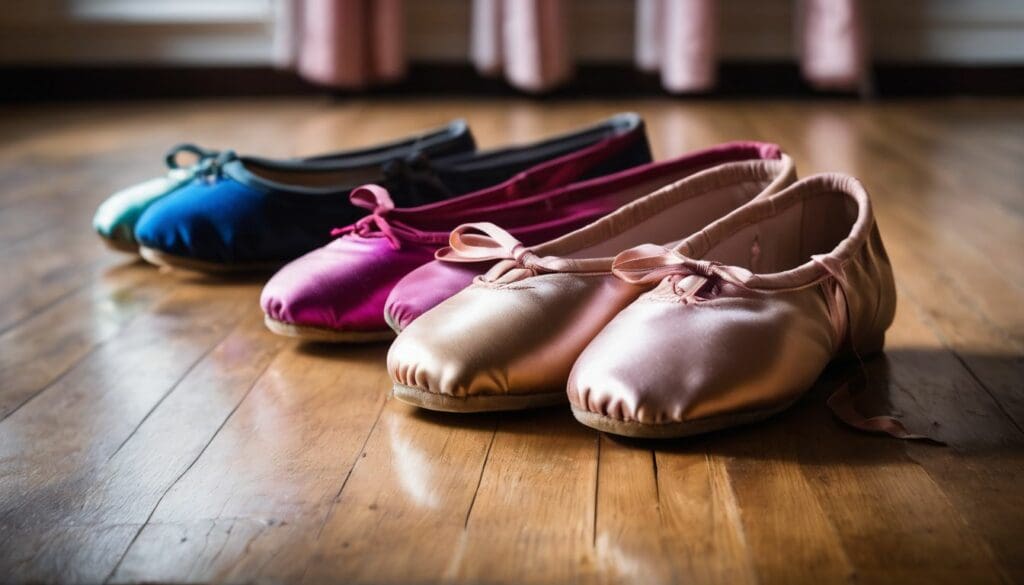Feeling sluggish and out of tune with your body? Dance isn’t just an art form—it’s a powerhouse for physical and mental rejuvenation. In this article, we’ll explore how regular dance can pump up your heart health, sharpen your mind, and lift your spirits.
Let’s get moving!
Key Takeaways
- Dance enhances heart health by increasing endurance and improving circulation, acting like a fun cardio workout.
- Engaging in dance regularly can lead to weight loss, muscle tone development, and better bone density, helping prevent conditions like osteoporosis.
- Dancing boosts mental health by releasing endorphins that reduce stress and improve mood, as well as sharpening memory recall through learning routines.
- Children who dance benefit from improved coordination, balance, social skills development, and creative expression.
- To get the most out of dancing, it’s important to practice consistently, choose a style that suits personal interests and goals while considering eco-friendly options.
The Physiological Benefits of Dance
Dance provides improved cardiovascular health, increased strength and flexibility, and aids in weight loss and improved bone health. These physical benefits make dance a great way to stay fit and healthy.
Improved cardiovascular health
Regular dance movement boosts your heart’s endurance and improves overall cardiovascular health. As you groove to the music, your heart rate increases, enhancing blood circulation and oxygen flow throughout the body.
This physical activity acts as an excellent workout for your heart and lungs, much like cycling or running.
Engaging in dance strengthens the muscles that support your cardiovascular system. Not only does it help build muscle tone, but it also encourages better posture and balance. The rhythmic movements involved in dancing push your body to work harder, which in turn helps develop a stronger musculoskeletal system – crucial for a robust heart function.
Increased strength and flexibility
Transitioning from improved cardiovascular health, regular dance and movement also contribute to increased strength and flexibility. Through dynamic movements and bodyweight exercises, dancers develop strong and toned muscles throughout their entire bodies.
This enhanced musculoskeletal strength leads to improved posture, balance, and endurance. Additionally, the active stretching involved in dancing promotes flexibility, which helps prevent injuries and joint stiffness while supporting overall physical well-being.
Dance contributes significantly to musculoskeletal strength by engaging various muscle groups through repetitive movements that build endurance over time. Simultaneously, the fluid motions of dance routines enhance flexibility by elongating muscles and improving range of motion across joints.
Weight loss and improved bone health
Regular dance and movement are effective for weight loss and improving bone health. Dancing can help maintain a healthy weight by burning calories, increasing metabolism, and building lean muscle.
This physical activity also promotes bone density, reducing the risk of osteoporosis and fractures due to the impact on bones during dancing routines.
If you’re interested in further enhancing your understanding of the physiological benefits of dance, let’s explore how it contributes to cardiovascular health.
The Psychological Benefits of Dance
Dance can boost self-confidence, reduce stress, and improve mental health. It has the power to elevate mood and enhance memory function.
Boosted self-confidence and reduced stress
Regular dance and movement can significantly improve self-confidence and reduce stress levels. Engaging in dance releases endorphins, which are the body’s natural feel-good chemicals, helping to alleviate feelings of anxiety and tension.
Dance also provides a sense of accomplishment as individuals master new moves and routines, boosting their self-esteem and confidence in their abilities.
Incorporating movement into everyday life through dance not only enhances physical health but also has profound positive effects on mental well-being. The mind-body connection established through dance fosters mindfulness, promoting relaxation and reducing stress.
Improved mental health and memory
Dance enhances mental health and memory by reducing stress and improving cognitive function. Engaging in regular dance activities stimulates the release of endorphins, which elevate mood and alleviate anxiety.
This leads to improved mental well-being, reduced risk of depression, and a sense of overall relaxation. Moreover, dance involves learning routines and steps, which can enhance memory recall over time as individuals commit movements to memory through practice.
Furthermore, the mind-body connection fostered by dance positively impacts cognitive functions such as attention span, multitasking ability, and overall brain health. The combination of physical activity with mental engagement provides a holistic approach to enhancing both mental health and memory for environmentally conscious individuals seeking wellness benefits through movement therapy.
The Benefits of Dance for Children and Adolescents
Children and adolescents who participate in regular dance experience improved physical and mental development, as well as increased social connectedness. This can lead to overall better health and wellbeing for young individuals.
Improved physical and mental development
Regular dance and movement can lead to improved physical and mental development. Dance enhances coordination, balance, and motor skills. It also fosters cognitive function, creativity, and emotional expression in individuals of all ages.
The combination of physical activity and artistic self-expression makes dance a valuable tool for nurturing holistic development.
Furthermore, dancing offers an opportunity for children to develop social skills through group participation while providing adolescents with a healthy outlet for stress relief. Likewise, adults can benefit from the mental stimulation that comes with learning new choreography or mastering complex dance routines.
Increased social connectedness
Regular dance and movement can lead to increased social connectedness, offering opportunities to meet new people who share similar interests. Through attending classes or participating in group performances, individuals can build friendships and a sense of community, creating a supportive environment for personal growth.
This social aspect of dance not only provides emotional support but also encourages collaboration and teamwork, contributing to a positive and enriching experience.
Engaging in regular dance activities allows individuals to connect with others in a meaningful way, fostering a sense of belonging and camaraderie that enhances overall well-being.
Tips for Dancing Well
To dance well, focus on mastering rhythm and timing, finding the right style and class that suits you, and practicing your moves outside of class to improve your skills. These tips can help you become a better dancer and enjoy the many benefits of regular movement.
Mastering rhythm and timing
To dance effectively, it’s important to master rhythm and timing. This involves developing a keen sense of musicality and being able to move in sync with the beat. By practising regularly and paying attention to the music, you can improve your ability to stay on tempo and execute movements with precision.
Having a strong grasp of rhythm also enhances coordination and helps prevent injuries by ensuring smooth transitions between steps. As you become more adept at timing your movements to the music, you’ll find that dancing becomes even more enjoyable and fulfilling.
Finding the right style and class
Choose a dance style that resonates with your personal interests and goals. Consider styles such as ballet, hip-hop, or contemporary dance, each offering unique benefits for physical fitness and self-expression.
Research local studios or fitness facilities that offer classes in your chosen dance style and consider their environmental impact, such as eco-friendly practices and green initiatives.
Look for classes taught by knowledgeable instructors who prioritise sustainability and organic living. Whether you’re interested in energetic group classes or one-on-one training, finding the right class can help you connect with like-minded individuals who share your passion for both dance and environmental conservation.
After selecting the appropriate style and class, commit to attending regular sessions to improve your skills while positively impacting your overall well-being through exercise. Remember to embrace sustainable habits by choosing eco-friendly dancewear made from natural materials when possible; this choice not only benefits the environment but also supports ethical production practices.
Practicing outside of class
After finding the right style and class, practising outside of class is essential for honing your dance skills. Regular practice helps improve muscle memory, coordination, and technique.
Utilise online tutorials, join local dance groups or schedule home practice sessions to reinforce what you’ve learned in class.
To further enhance environmental consciousness, consider dancing outdoors or in eco-friendly spaces whenever possible. This promotes appreciation for nature while enjoying the physical and mental benefits of movement in a sustainable manner.
How to Get Started with Dance
Choose a dance style that interests you, find classes at local studios or fitness facilities, or explore online resources to start your dance journey. Ready to learn more about the benefits of regular dance and movement? Keep reading to discover how dancing can improve your physical and mental well-being!
Choosing a dance style
When considering a dance style, take into account personal preferences and interests. Research different styles such as ballet, hip-hop, or salsa to find one that resonates with you.
Look for classes that cater to your skill level and offer an environmentally friendly approach, such as those held in sustainable studios or community centers.
Ensure the chosen dance style aligns with environmental values by seeking out eco-conscious instructors who promote sustainable practices within their classes. Consider exploring traditional dances from various cultures for a more holistic appreciation of movement while supporting diversity and inclusion within the dance community.
Taking classes at a studio or fitness facility
Joining a dance class at a local studio or fitness facility offers the opportunity to engage in physical activity while contributing to environmental conservation. By participating in group classes, individuals can reduce their carbon footprint by sharing resources such as electricity and water usage, while also minimising transportation emissions.
Additionally, attending regular classes encourages sustainable habits and supports eco-friendly businesses within the community.
Dance studios often promote environmentally conscious practices, such as using energy-efficient lighting and recycled materials in their facilities. Supporting these establishments not only provides access to fitness benefits but also aligns with an individual’s commitment to environmental preservation.
Utilizing online resources
To incorporate dance into your routine, consider utilising online resources. You can find a variety of tutorials and classes on video platforms and specialised dance websites. These resources offer flexibility for your schedule and allow you to explore different styles from the comfort of your home.
Additionally, they provide an opportunity to learn from experienced instructors at a pace that suits you.
As an environmentally conscious individual, accessing online resources reduces the need for travel and printed materials while still allowing you to benefit from dance and movement practices.
Conclusion
In summary, regular dance and movement offer numerous benefits for both the body and mind. Dance contributes to improved cardiovascular health, increased strength, and enhanced flexibility.
It also boosts self-confidence, reduces stress, and enhances mental wellness. For children and adolescents, dance supports physical and mental development while promoting social connectedness.
Whether mastering rhythm or choosing the right style, dancing offers a holistic approach to fitness that anyone can enjoy.
FAQs
1. What are the fitness advantages of regular dance and movement?
Regular dance and movement offer tremendous fitness advantages, including improved flexibility, strength training, and overall exercise benefits.
2. Can dancing help reduce stress?
Yes, engaging in dance can be a form of therapy that helps in stress reduction by promoting a strong mind-body connection.
3. Is dance considered good exercise for everyone?
Dance is an excellent form of exercise that benefits people of all ages because it combines physical activity with enjoyment.
4. How does dance therapy support mental health?
Dance therapy utilises movement to enhance emotional well-being, fostering a healthier mind-body connection which is beneficial for mental health.





